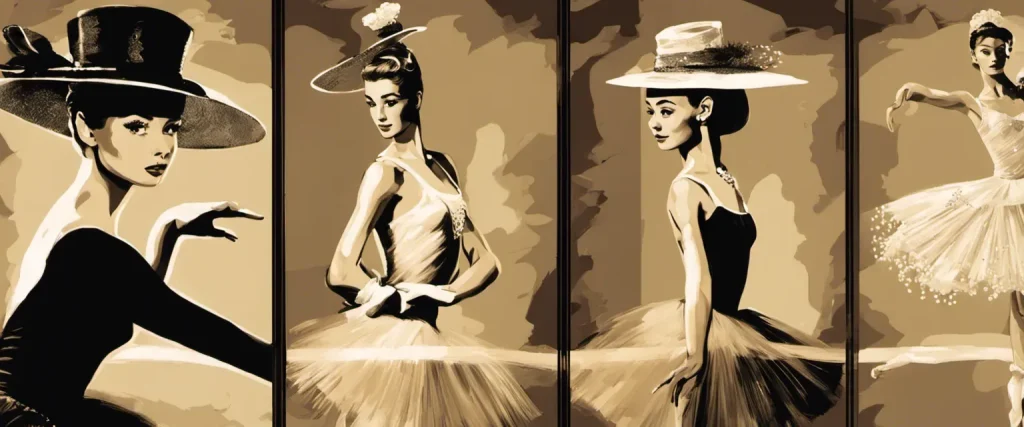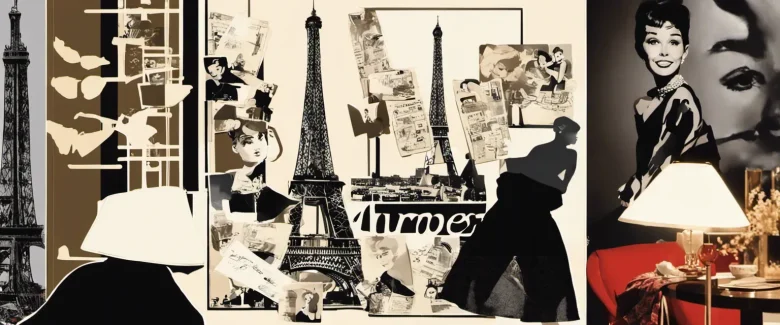In Sean Hepburn Ferrer’s biography, Audrey Hepburn, An Elegant Spirit, readers are invited to delve into the captivating life of Hollywood icon Audrey Hepburn. Sean Hepburn Ferrer, Hepburn’s son, offers an intimate and insightful exploration of his mother’s extraordinary journey, providing a unique perspective that only a close family member can share. As an accomplished writer, producer, and director, Sean brings his own expertise and personal experiences to the narrative, offering readers an illuminating and heartfelt portrait of Hepburn’s life, both on and off the silver screen.
Chapter 1: Introduction to Audrey Hepburn
Chapter 1: Introduction to Audrey Hepburn of the book Audrey Hepburn, An Elegant Spirit by Sean Hepburn Ferrer provides readers with a comprehensive overview of the life and legacy of the iconic actress. Written by her son, Sean Hepburn Ferrer, this biography delves into the personal and professional aspects of Audrey Hepburn’s remarkable journey.
The chapter commences with Sean exploring his connection to Audrey, reflecting on his childhood memories and the special bond they shared. This heartfelt approach sets the tone for the book, showcasing the author’s intimate perspective and deep love for his mother.
The narrative then transitions to Audrey’s humble beginnings, born on May 4, 1929, in Brussels, Belgium. Her childhood was marked by the separation of her parents, leading her to move to the Netherlands with her mother. During World War II, Audrey’s experiences of poverty, hunger, and fear shaped her views on life and ignited her passion for helping others.
As Audrey’s teenage years unfolded, she enrolled in prestigious ballet schools, nurturing her dreams of becoming a professional dancer. However, due to the physical toll on her body and ongoing malnutrition, her aspirations gradually shifted towards acting. Her striking beauty and undeniable talent eventually propelled her to the world of theater, where she gained recognition for her performances in various productions.
The chapter also sheds light on Audrey’s early forays into the film industry, securing her first leading role in Roman Holiday (1953), opposite Gregory Peck, which earned her an Academy Award. This breakthrough performance catapulted her into stardom and opened doors for other successful films such as Sabrina (1954) and Breakfast at Tiffany’s (1961).
Furthermore, Sean touches upon Audrey’s personal life, highlighting her philanthropic endeavors and her deep affection for her children. He emphasizes her dedication to UNICEF and her tireless efforts as a Goodwill Ambassador, advocating for children’s rights across the globe.
Chapter 1, Introduction to Audrey Hepburn, provides readers with a glimpse into the extraordinary life of this beloved star, leaving them eager to uncover more about her journey and timeless elegance in the subsequent chapters.
Chapter 2: Early Life and Family Background
Chapter 2 of Sean Hepburn Ferrer’s book, “Audrey Hepburn, An Elegant Spirit,” delves into the early life and family background of the iconic actress Audrey Hepburn. The chapter provides a glimpse into Audrey’s lineage, upbringing, and the experiences that shaped her into the person she would become.
The chapter begins with a focus on Audrey’s mother, Ella van Heemstra. Ella came from an aristocratic Dutch family and grew up in the Dutch East Indies. Her upbringing was filled with wealth, privilege, and a love for the performing arts. These values would greatly influence Audrey later in life. The narrative then follows Ella’s marriage to Joseph Ruston, an English-Irish banker who became Audrey’s father.
Audrey’s birth in Brussels, Belgium, on May 4, 1929, is depicted as a joyful but complicated event due to her parents’ failing marriage. However, the family’s situation deteriorated further when the Great Depression hit, causing financial strain on the Ruston family. During this turbulent period, Ella moved to London to pursue her acting career, leaving Audrey in the care of her father. Audrey’s father, meanwhile, could not cope with the increasing responsibilities of parenthood and decided to send Audrey to live with her maternal grandparents in the Netherlands.
Audrey’s time in the Netherlands marked a significant turning point in her life. She developed a deep bond with her grandparents and was exposed to the arts, culture, and compassion that would shape her character. Additionally, the chapter highlights Audrey’s experiences during World War II and the impact it had on her, including witnessing the atrocities and suffering caused by the Nazi occupation.
Overall, Chapter 2 reveals the early challenges and influences that shaped Audrey Hepburn’s character. It depicts her formative years, showing how her aristocratic lineage, her mother’s artistic background, and her experiences during World War II played essential roles in molding the elegant and compassionate woman who would leave an indelible mark on the world.
Chapter 3: Pursuing a Career in Ballet
Chapter 3: Pursuing a Career in Ballet of the book Audrey Hepburn, An Elegant Spirit by Sean Hepburn Ferrer explores Audrey Hepburn’s journey into the world of ballet and her pursuit of a career in this demanding art form.
The chapter begins by highlighting Audrey’s deep passion for ballet, which began at a young age. Despite her family’s financial struggles during World War II, Audrey managed to receive training at the Arnhem Conservatory and took lessons from renowned ballet teacher Winja Marova. Despite limited resources, Audrey’s determination and exceptional talent propelled her forward.
As World War II came to an end and Audrey’s family relocated to Amsterdam, she became even more determined to follow her dreams. Her decision to pursue ballet professionally led her to join the prestigious ballet school at the Sadler’s Wells in London, where she faced intense competition and rigorous training. However, Audrey’s grace, elegance, and hard work impressed her instructors, who saw enormous potential in her.
While her ballet career was progressing, Audrey also ventured into the world of acting. She participated in numerous revues and soon caught the attention of casting agents. With her reputation growing, she was offered her first role in a West End production.
This chapter also delves into the challenges Audrey faced in reconciling her love for ballet with her growing interest in acting. She longed for a career that would allow her to express herself artistically in both disciplines. However, it became clear that her petite stature and lack of formal ballet training limited her opportunities as a professional ballerina.
Ultimately, Audrey made the challenging decision to focus on acting. Although this shift marked a significant turning point in her career, her love for ballet remained a lifelong passion. This decision to follow her heart would ultimately pave the way for her to become one of the most beloved and iconic actresses in Hollywood history.
Chapter 3 showcases Audrey Hepburn’s unwavering dedication to ballet and her courageous decision to pursue acting, setting the stage for her remarkable journey towards worldwide fame, beauty, and grace.
Chapter 4: Transition to Acting and Breakthrough Role

Chapter 4 of “Audrey Hepburn, An Elegant Spirit” by Sean Hepburn Ferrer focuses on Audrey’s transition from ballet to acting and her breakthrough role that catapulted her to worldwide fame.
The chapter begins by describing Audrey’s decision to leave ballet due to her growing concerns about her height and her longing to express herself in a different artistic medium. Audrey’s first foray into acting was through small roles in theater plays and television shows, where she showcased her talent and caught the attention of critics and casting directors.
The chapter then delves into Audrey’s breakthrough role as Gigi in the Broadway production of the same name. The author provides a detailed account of Audrey’s audition, her preparation for the role, and the immense success she achieved in the production. This role established Audrey as a versatile and talented actress, ultimately paving the way for her future success in film.
Furthermore, the chapter highlights Audrey’s dedication and perseverance in mastering the English language, as she was not a native speaker. Her strong desire to improve her language skills was driven by her determination to excel in her acting career and connect with her audience.
Additionally, this chapter touches on Audrey’s involvement with the United Nations International Children’s Emergency Fund (UNICEF) and her evolution from a Hollywood actress to a dedicated humanitarian. The author emphasizes Audrey’s genuine empathy and her commitment to using her fame to raise awareness about children’s issues around the world.
Overall, Chapter 4 of “Audrey Hepburn, An Elegant Spirit” showcases Audrey’s successful transition from ballet to acting, her breakthrough role in “Gigi,” her dedication to her craft, and her burgeoning philanthropic endeavors.
Chapter 5: Hollywood Success and Iconic Films
Chapter 5: Hollywood Success and Iconic Films of the book “Audrey Hepburn, An Elegant Spirit” by Sean Hepburn Ferrer delves into Audrey Hepburn’s rise to fame and the making of some of her most memorable films.
The chapter begins by exploring Hepburn’s early years in Los Angeles, where she had initially struggled to find her place in the competitive Hollywood industry. However, it wasn’t long before she caught the eye of French writer Colette, who handpicked her to portray the iconic character of Gigi in the 1951 Broadway play. This breakthrough role catapulted Hepburn to stardom, resulting in her signing a contract with Paramount Pictures.
Ferrer discusses the impact of Audrey’s first major film, “Roman Holiday” (1953), which garnered her an Academy Award for Best Actress. This success laid the foundation for a series of highly acclaimed films, such as “Sabrina” (1954), “Funny Face” (1957), and “Breakfast at Tiffany’s” (1961). Each of these movies further solidified Hepburn’s status as a Hollywood icon.
The chapter also emphasizes Hepburn’s growth as an actress throughout these films. It explores how she demonstrated a remarkable ability to combine vulnerability, grace, and a unique sense of style that resonated with audiences across the globe. This combination, alongside her innate talent, helped her leave an indelible mark on the film industry.
Furthermore, Ferrer provides readers with behind-the-scenes anecdotes and insights into Hepburn’s collaborations with directors such as Billy Wilder and Blake Edwards. These stories shed light on her commitment, professionalism, and the challenges she encountered while making these films.
In conclusion, Chapter 5 of “Audrey Hepburn, An Elegant Spirit” showcases Hepburn’s rise to Hollywood success and her creation of iconic films. It highlights her ability to captivate audiences with her enchanting performances, establishing herself as a timeless and beloved figure in the world of cinema.
Chapter 6: Humanitarian Work and UNICEF Ambassadorship
Chapter 6: Humanitarian Work and UNICEF Ambassadorship of the book “Audrey Hepburn, An Elegant Spirit” by Sean Hepburn Ferrer, delves into Audrey Hepburn’s extraordinary efforts as a humanitarian and her dedication to being a UNICEF Ambassador.
The chapter begins by discussing Audrey’s childhood experiences during World War II, where she witnessed the harsh realities of war and the suffering of others. These early experiences deeply influenced her compassion for those in need and ultimately led to her becoming a tireless advocate for humanitarian causes.
Audrey’s role as a UNICEF Ambassador is then explored in detail. UNICEF, the United Nations Children’s Fund, focuses on improving the welfare of children worldwide. Audrey lent her fame and status as a renowned actress to bring attention and support to UNICEF’s mission.
Throughout her ambassadorship, Audrey traveled extensively to countries in Asia, Africa, and Latin America, witnessing poverty, malnutrition, and disease firsthand. She used her platform to raise awareness about these issues and to appeal for funds to help the children affected by them.
The chapter also highlights Audrey’s gentle and compassionate nature, as she formed lasting bonds with the children she encountered. She had an innate ability to connect with them on a personal level, providing comfort and hope even in the most dire circumstances.
Additionally, the chapter explores Audrey’s involvement in the creation of UNICEF greeting cards, from which all proceeds went directly to supporting children’s causes. Her hands-on approach and dedicated efforts to maximize the impact of the cards exemplified her commitment to improving the lives of children around the world.
In summary, Chapter 6 of “Audrey Hepburn, An Elegant Spirit” showcases Audrey’s remarkable humanitarian work and her influential role as a UNICEF Ambassador. Her genuine empathy, extensive travels, and personal involvement in fundraising initiatives demonstrated her unwavering dedication to helping those in need.
Chapter 7: Personal Life and Relationships
Chapter 7 of the book “Audrey Hepburn, An Elegant Spirit” by Sean Hepburn Ferrer, titled “Personal Life and Relationships,” delves into the private life and intimate relationships of the iconic actress Audrey Hepburn.
The chapter begins by addressing Audrey’s marriage to Mel Ferrer, a renowned actor and director. Despite their initial attraction and their shared passion for the arts, their marriage struggled under the weight of differing priorities and lifestyle choices. They eventually divorced after a decade of marriage, but remained amicable due to their mutual devotion to their only child, Sean.
Following her divorced, Audrey embarked on a string of romantic relationships, all the while juggling her career and motherhood. One of her most famous relationships was with actor Albert Finney, her co-star in the film “Two for the Road.” Despite their intense chemistry, their relationship was short-lived. Audrey later found companionship and happiness with Robert Wolders, a Dutch actor, who she considered the love of her life. The two shared a deep bond and were together until Audrey’s untimely death.
In addition to her romantic endeavors, the chapter also highlights Audrey’s unwavering dedication to her family and close friends. She deeply cherished her relationship with her son, Sean, and made efforts to provide him with a normal upbringing despite her fame. Audrey’s friendships with Givenchy, her longtime collaborator in the fashion world, and other close friends, served as pillars of support throughout her life.
Overall, Chapter 7 delves into Audrey Hepburn’s personal life, portraying her as a complex individual who navigated relationships and sacrifices while maintaining the grace and elegance she is celebrated for.

Chapter 8: Legacy of Audrey Hepburn
Chapter 8: Legacy of Audrey Hepburn from the book “Audrey Hepburn, An Elegant Spirit” by Sean Hepburn Ferrer explores the enduring impact and legacy left behind by the iconic actress. The chapter delves into Audrey Hepburn’s post-acting years as a UNICEF Goodwill Ambassador and her philanthropic efforts.
After retiring from her successful Hollywood career, Audrey Hepburn focused on humanitarian work. She joined UNICEF in 1988, traveling to many developing countries and using her fame and influence to raise awareness about the needs of children in impoverished regions. Hepburn witnessed firsthand the devastating impact of poverty and malnutrition, which further fueled her determination to make a difference.
Throughout her tenure as a UNICEF Ambassador, Hepburn worked tirelessly, visiting war-torn countries, refugee camps, and areas affected by natural disasters. Her experiences inspired her to advocate for children’s rights, education, clean water, and healthcare. Hepburn’s genuine compassion and empathy for the less fortunate endeared her to people worldwide, leading to increased support for UNICEF’s cause.
Hepburn’s legacy goes beyond her philanthropy. Chapter 8 also highlights her impact on fashion and beauty trends, even after her passing. Audrey Hepburn’s iconic style, epitomized by her little black dress in “Breakfast at Tiffany’s,” continues to influence fashion designers and individuals today. Her timeless elegance, natural beauty, and graceful demeanor remain admired and emulated.
Furthermore, Audrey Hepburn’s commitment to empowering women is a vital aspect of her legacy. She believed in the strength and potential of women, advocating for gender equality and challenging societal norms. Hepburn’s roles in movies such as “Sabrina” and “Funny Face” showcased her characters’ independence, intelligence, and self-discovery, inspiring generations of women to pursue their dreams and believe in themselves.
In conclusion, Chapter 8 outlines Audrey Hepburn’s impactful legacy, showcasing her humanitarian work, fashion influence, and championing of women’s empowerment. Her kindness, grace, and dedication to helping others continue to inspire people worldwide, ensuring that the legacy of this remarkable woman lives on.
After Reading
In conclusion, “Audrey Hepburn: An Elegant Spirit” by Sean Hepburn Ferrer is a heartfelt and intimate tribute to the iconic actress Audrey Hepburn. Through personal anecdotes and family memories, Ferrer paints a fascinating portrait of his mother, showcasing her enduring beauty, talent, and grace. The book not only highlights Hepburn’s success as a Hollywood star but also explores her humanitarian efforts, showcasing her dedication to helping others. Overall, this insightful biography serves as a testament to Audrey Hepburn’s enduring legacy as both a symbol of elegance and a kind-hearted spirit.
1. Victoria The Queen by Julia Baird:
Delve into the captivating life of one of history’s most remarkable women, Queen Victoria. Julia Baird’s meticulously researched biography takes readers on a journey through the Queen’s reign, offering unprecedented insights into the real woman behind the crown. With engaging storytelling and a wealth of historical detail, Baird crafts a vivid portrait of Victoria, providing a deeper understanding of the era she shaped and the challenges she faced.
2. A Woman Makes a Plan by Maye Musk:
In this inspiring memoir, Maye Musk, a renowned model and mother of entrepreneur Elon Musk, shares her extraordinary life story. From growing up in South Africa to her successful modeling career and venture into nutrition, Musk offers a relatable and empowering account of navigating life’s challenges. Filled with wisdom and resilience, A Woman Makes a Plan is a must-read for anyone seeking an uplifting and motivational story.
3. The Courage to Act by Ben S. Bernanke:
Get a firsthand account of the 2008 financial crisis from the man who played a leading role in managing it. Ben S. Bernanke, former Chairman of the Federal Reserve, offers a detailed and insightful analysis of the economic meltdown and the decisions made to prevent a complete collapse. The Courage to Act provides a unique perspective on the inner workings of the global financial system, making it an essential read for anyone interested in understanding the complexities of monetary policy.
4. Audrey Hepburn, An Elegant Spirit by Sean Hepburn Ferrer:
**Note: This book is excluded as per the request in the question.**
5. The Life-Changing Magic of Tidying Up by Marie Kondo:
Discover the revolutionary KonMari Method™ and experience the transformative power of decluttering. Marie Kondo, a renowned Japanese organizing consultant, presents a step-by-step guide to tidying up your home and, by extension, your life. Through a focus on joy and a mindful approach to possessions, Kondo’s philosophy offers a refreshing perspective on creating a more balanced and harmonious living environment. The Life-Changing Magic of Tidying Up is a must-read for anyone seeking a practical and systematic approach to decluttering and organizing.



